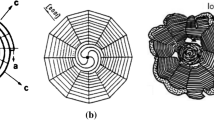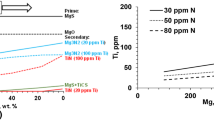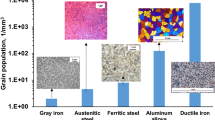Abstract
The influence of oxides and sulfides in gray cast iron on the growth morphologies of MnS and on the nucleation of graphite was experimentally investigated using scanning electron microscopy and energy-dispersive X-ray spectroscopy (SEM-EDX) analysis with evidences that shows the possible nucleation sites for graphite nucleation. Thermodynamic studies have been done on the influence of varying sulfur concentrations on the nucleation of MnS in the melt and during solidification. The consumption of dissolved oxygen and sulfur in the melt during the cooling process was analyzed and we explored how this influenced the nucleation process of oxides and sulfides. A sequential nucleation concept of oxides and MnS is proposed in relation to the growth morphology of MnS and graphite with respect to the mechanical properties of cast iron. The nucleation of new oxides and sulfides was analyzed using thermodynamics and compared to our experimental results. Graphite nucleation on substrates other than MnS, such as MoS2 oxides and (Mo,Cr)S, was experimentally analyzed along with the influence of the substrates on graphite nucleation and growth morphology.













Similar content being viewed by others
References
R. J. Warrick: AFS Trans., 1966, vol. 74, pp. 722–33.
K. M. Muzmudar and J. F. Wallace: AFS Trans., 1972, vol. 80, pp. 317-28.
K. M. Muzmudar and J. F. Wallace: AFS Trans., 1973, vol. 81, pp. 412-23.
M.H. Jacobs, T.J. Law, D.A. Melford, and M.J. Stowell: Met. Technol., 1974, vol. 1, p. 490–500.
M.A. Gadd and H.H.J. Bennett: 3rd International Symposium on the Physical Metallurgy of Cast Iron, Elsevier, Stockholm, 1984, p. 99.
T. Kusakawa, S. Okimoto, K. Koayashi, Kazoo IDE, and H. Okita: Report of the Casting Research Laboratory, Waseda University, n. 39, 1988, pp. 25–32.
J. Campbell: Metall. Mater. Trans. B, 2009, 40B, pp. 786-801.
I. Riposan, M. Chisamera, S. Stan and D. White: International Journal of Cast Metals Research, 2007, vol. 20, pp. 90-7.
I. Riposan, M. Chisamera, S. Stan and T. Skaland: International Journal of Cast Metals Research, 2003, vol. 16, n. 1-3, pp. 105-11.
I. Riposan, M. Chisamera, S. Stan and D. White: China Foundary, 2009, vol. 6, n. 4, pp. 352-57.
I. Riposan, M. Chisamera, S. Stan, C. Hartung and D. White: Mater. Sci. Technol. 2010, col. 26, n. 12, pp. 1439-47.
I. Riposan, M. Chisamera, S. Stan, Eduard Stefan and C. Hartung: Key Eng. Mater. 2011, vol. 457, pp. 19-24.
A. Velickhko and F. Mücklich: Int. J. Mater. Res., 2009, vol. 100, n. 8, pp. 1031-37.
T. Skaland: Ph.D. Thesis, Metallurgisk Institutt, Trondheim, Norway, 1992.
H. Gu and L. Weidong: Adv. Mater. Res., 2011, vol. 299-300, pp. 576-79.
A. Sommerfeld and B. Tonn: J. Mater. Sci. Technol., 2008, vol. 24, n. 3, pp. 321-24.
G.M. Goodrich, T.G. Oakwood and R.B. Gundlach: AFS Trans., 2003, pp. 783–12.
E. Fraś and M. Górny: Key Eng. Mater., 2011, vol. 457, pp. 137-42.
C.H. Wang and H. Fredriksson: 48th International Foundry Congress., Varna, 1981, p. 16.
J. Ekengård and A. Diószegi: Proceedings of the Carl Loper Cast Iron Symposium, Madison, Washington, 2009.
F. Lietaert: Giessereiforschung, 1997, n. 3, vol. pp. 106-23.
E. B. Ten: Key Eng. Mater., 2011, vol. 457, pp. 43-47.
E. Fraś, H. F. López and C. Podrzucki: Int. J. Cast Metal Res., 2000, vol. 13. pp. 107-21.
A. D. Sy: AFS Trans., 1967, vol. 75, pp. 161-72.
A. Roula and G. A. Kosnikov: Mater. Lett., 2008, vol. 62, pp. 3796-99.
L. Magnusson: Ph.D. Thesis, Royal Institute of Technology, Stockholm, Sweden, 2006.
J. F. Elliott, M. Gleiser and V. Ramakrishna: Thermochemistry for Steelmaking, vol. 2, p. 547-67, Addison-Wesley, London, 1963.
O. Kubaschewski and C. B. Alcock: Metallurgical Thermochemistry, 5th ed., Pergamon Press Ltd., England, 1979, p. 19.
O. Kubaschewski and C. B. Alcock: Metallurgical Thermochemistry, 5th ed., Pergamon Press Ltd., England, 1979, p. 274–384.
M.W. Chase, Jr.: NIST-JANAF Themochemical Tables, 4th ed., J. Phys. Chem. Ref. Data, Monograph 9, 1998, p. 1-1951.
E.A. Brandes and G.B. Brook: Smithels Metals Reference Book, 7th ed., Butterworth-Heinemann Ltd., Oxford, England, 1992, p. 8/1–8/51.
J.F. Elliott and M. Gleiser: Thermochemistry for Steelmaking, vol. 1, Addison-Wesley, London, 1960, p. 31–105.
H. Fredriksson and U. Åkerlind: Materials Processing During Casting, p. 280-91, John Wiley, England, 2005.
H. Fredriksson and U. Åkerlind: Material: Royal Institute of Technology, Stockholm, Sweden, Crystallization Processing, vol. 2, unpublished research, 2011, p. 77.
A. Kagawa, K. Lwata, A. A. Nofal and T. Okamoto: Materials Science and Technology, 1985, vol. 1, pp. 678-83.
G. A. Jenner, S. F. Foley, S. E. Jackson, T. H. Green, B. J. Fryer and H. P. Longerich: Geochemica et Cosmochemica Acta, 1994, vol. 58, pp. 5099-5103.
T. P. Battle and R. D. Pehlke: Metall. Trans. B, 1989, vol. 20B, pp. 149-60.
Acknowledgments
The authors would like to thank Dr. Lena Magnusson for initiating the collaboration. Financial support provided by ELKEM-Norway is gratefully acknowledged.
Author information
Authors and Affiliations
Corresponding author
Additional information
Manuscript submitted May 26, 2012.
Appendices
Appendices
In all calculations, the concentration values are reported in wt pct, temperature in Kelvin, and ΔG in J/mol. The activities of SiO2, Al2O3, CaO, CaS, SrO, SrS, MnS, and MoS2 are assumed to be equal to one.
Appendix A: SiO2
The oxygen concentration in the melt is determined by assuming thermodynamic equilibrium between Si and SiO2 using the reaction \( {\text{Si}}_{l} + 2[{\text{O}}]_{l} \leftrightarrow {\text{SiO}}_{2(S)} \). Considering activity, \( a_{M/O} = C_{M/O} *f_{M/O}^{melt} \).[27]
Appendix B: Al2O3
The reference state for the calculation is an infinitely dilute solution of oxygen in pure liquid iron. The reaction is \( 2{\text{Al}}_{\text{s}} + 3[{\text{O}}]_{l} \leftrightarrow {\text{Al}}_{2} {\text{O}}_{{3({\text{s}})}} \).[27]
Appendix C: SrO
The Gibbs energy for SrO formation is calculated using Eq. [C1].[28] Values for entropy, enthalpy, and heat capacity are taken from Kubaschewski et al.[29] with the exception of CpSrO,[30] which represents a solid-phase heat capacity. The interaction coefficients of Sr to other metals are unknown.
Appendix D: CaO
The free energy of formation of CaO is calculated from Eq. [C1] in two steps. The free energy for the phase changes that occur in Ca at 737 K and 1123 K (464 °C and 850 °C) is calculated as
The total free energy of formation of CaO is given in Eq. [D2].
The interaction coefficients for Ca with O and S are unknown.
Appendix E: CaS
The free energy of CaS formation is calculated using Eq. [C1] by considering the phase changes in S and Ca at different temperatures. The total free energy of S while cooling results in the formation of a monoatomic gas phase initially, followed by a liquid phase and then a solid phase as given by Eq. [E1].
The total free energy of CaS formation is given in Eq. [E2], by substituting ΔGCa from Eq. [D1].
Appendix F: MnS
Free energy of formation of MnS particles in the melt is given by Eq. [F1].[27]
Appendix G: MoS2
Free energy of formation of MoS2 is calculated using Eq. [C1]. The free energy for the phase changes in sulfur is given in Eq. [E1]. All of the data for MoS2 are taken from the Smithells Metals reference book,[31] except for \( { {Cp}^{{MoS}_{2}} } \),[30] which is the solid-phase heat capacity.
\( f_{Mo} = 10^{{0.021C_{O} - 0.07C_{C} - 0.078C_{N} }} = 0.572 \) (from Appendix F).
Appendix H: SrS
The free energy of formation of SrS is calculated using Eq. [H1].
By substituting values from Elliott et al.[32] and Smithells[31] into Eq. [H1], we obtain the total Gibbs free energy given in Eq. [H5].
Appendix I: Supersaturation Models During Solidification
The minimum energy required to nucleate a particle is given as[33]
The difference in the interaction coefficient on both sides is small and can therefore be neglected. Thus, we obtain the required equation for the supersaturation of particles that nucleate in the liquid between the dendrite arms as Eq. [I2].[33]
Scheil’s equation is used for the segregation of Mn, Al, and Sr, while lever rule is used for the segregation of sulfur and oxygen[34] and to calculate the supersaturation of oxide/sulfide as a function of the solid fraction. Equation [I3] is for microsegregation prior to eutectic reaction, while Eq. [I4] is used after eutectic reaction.
Molar volumes are \( V_{m}^{{M_{x} N_{y} }} = 21.8*10^{ - 6} \left( {\text{MnS}} \right); 20.3*10^{ - 6} \left( {\text{SrO}} \right); 34.33*10^{ - 6} ({\text{Al}}_{2} {\text{O}}_{3} ) \) . Partition coefficient are \( k_{\text{O}}^{\frac{y}{l}} = 0.054 \)[33] \( k_{\text{Si}}^{\frac{y}{l}} = 1.3 \)[35]; \( k_{\text{graphite}}^{l} = 0.48 \)[35]; \( k_{\text{Sr}}^{{\frac{\gamma }{l}}} = 0.031 \)[36]; \( k_{\text{Ce}}^{{\frac{\gamma }{l}}} \cong k_{\text{Ca}}^{{\frac{\gamma }{l}}} = 0.063 \)[36]; \( k_{\text{Al}}^{{\frac{\gamma }{l}}} = 0.9 \)[37]; \( k_{\text{S}}^{{\frac{\gamma }{l}}} = 0.05 \)[37]; \( k_{\text{Mn}}^{{\frac{\gamma }{l}}} = 0.6 \)[35]; \( f_{\text{primary}}^{\gamma } = \frac{(3.709 - 3.4)}{(3.709 - 1.687)} = 0.152 \). The weight fraction of graphite at the eutectic point is \( f_{E}^{\text{gr}} = \frac{{\rho_{\gamma } }}{{\rho_{\text{gr}} }}*\left( {\frac{3.4 - 1.687}{100 - 1.687}} \right) = 0.0624 \), \( f_{gr}^{vol} = 0.0624*f_{remaining \; liq.} = 0.0528 \); \( f_{{(1 - {\text{gr}})}}^{\text{vol}} = \left( {1 - f_{E}^{\text{gr}} } \right)*f_{{{\text{remaining}}\,{\text{liq}}.}} + f_{\text{primary}}^{\gamma } = 0.947 \), \( f_{\text{solidfied}}^{\text{total}} = f_{\text{gr}}^{\text{vol}} + f_{\gamma }^{\text{vol}} \).
Notations Index
C = concentration in wt pct; f M,O,S = interaction co-efficient of metal atoms and oxygen or sulfur atom in the melt; T = temperature in kelvin; ΔH° = standard heat of formation in J mol−1; ΔCp = change in heat capacity in J k−1 mol−1; ΔS° = standard change in entropy in J k−1; ln kp = natural logarithm of the equilibrium constant from reference state. (s, l, g) = solid, liquid, and gas respectively; ΔG a = activation energy in J mol−1; ΔG n = driving force of nucleation; K B = Boltzmann’s constant in J k−1 = 1.38e-23; σ = surface tension in J m−2; V M = molar volume of metal oxide or sulfide in m3 mol−1; C M,N = concentration of metal atoms or Oxygen/sulfur atoms in the liquid in wt pct; C o(M,N) = initial concentration of metal atoms of oxygen/sulfur atoms in the liquid; (C M,N)eq = equilibrium concentration of metal atoms or other; f γ,gr,E = solid fraction of austenite or graphite or eutectic phase, respectively, in the volume; ρ = density Kg m−3.
Rights and permissions
About this article
Cite this article
Muhmond, H.M., Fredriksson, H. Relationship Between Inoculants and the Morphologies of MnS and Graphite in Gray Cast Iron. Metall Mater Trans B 44, 283–298 (2013). https://doi.org/10.1007/s11663-012-9768-6
Published:
Issue Date:
DOI: https://doi.org/10.1007/s11663-012-9768-6




